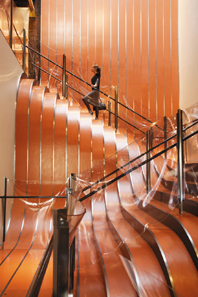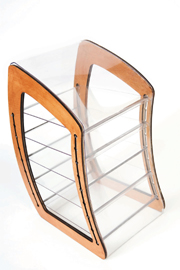|
Measuring Up Materials for Visual Merchandising Applications
A Q & A with Ken Lilly,
Technical Associate,
Specialty Plastics Film
and Sheet, Eastman
Chemical Company

When choosing materials for
designing and creating
store environments, there
are multiple factors that play a role
in the ultimate look and feel of the
space. Retailers are constantly
searching for innovative, functional
designs that attract consumers.
Safety, environmental impacts and
cost are also important considerations
in today’s increasingly competitive
and eco-conscious atmosphere. And with so many
choices for materials that meet all of these standards, the
decision on the right solution can be overwhelming.
PD®&F recently discussed the advantages and disadvantages
of the numerous materials available for designing
and implementing creative
retail environments with Ken
Lilly, Technical Associate from
Eastman Chemical Company.
PD®&F: What choices do designers
and retailers have for creating
store fixtures and displays?
KL: The material choices for
designers and retailers are vast,
giving them ample opportunity
to differentiate their brands as
well as their overall store environments.
Plastics, such as
PETG, polycarbonate and
acrylic, are popular because
they offer product visibility as
well as cost advantages over
products such as metal, wood
and glass. Thin gauges of PETG
function well structurally and
economically. However, retailers
and designers are also focusing
on natural products for their
aesthetic qualities and sustainability.
Combinations with these
natural products and PETG offer
great appeal, good function, and
extended endurance.
PD®&F: What industry trends are
impacting these material choices?
KL: Recently, sustainability has
become a factor for store design
and the materials currently being
used reflect this trend. More
thought is being given to the manufacturing
processes, shipping and
durability of materials. For example, PETG is gaining popularity
for its design flexibility and impact resistance. The
material enables designers to design intricate, threedimensional
retail environments while PETG’s toughness
reduces breakage and enables sheet to be downgauged,
resulting in less material usage
and reduced shipping costs.
Additionally, SRI Consulting,
the world’s leading business
research service for the global
chemical industry, found that
the total embodied energy used
to manufacture PETG (from
mono mers to a finished polymer
pellet) is significantly less than
acrylic and polycarbonate. All of
these factors contribute to the
overall sustainability of a store
environment, which is becoming
increasingly important to both
retailers and consumers.
Many retailers are limiting the
use of temporary displays to
keep aisles easy to negotiate. As
a result, permanent displays
must be versatile and able to
withstand constant product
turnover. Avant garde displays
are also becoming increasingly
popular, especially in luxury and
high-fashion stores. With this
type of display, designers tend
to use a variety of materials for
contrast such as pairing glass or
metallic pieces with recycled
timbers.
PD®&F: What advantages does
PETG offer over non-plastic
Materials?
KL: The design flexibility of PETG
offers designers and retailers the
ability to create intricate store
fixtures and point-of-purchase
displays without sacrificing
strength and durability. The
material can easily cold bend,
enabling innovative designs not
possible with glass or wood.
Many retailers are finding that
due to its clarity, PETG is an
excellent choice for shelving.
Unlike wood or metal, consumers
can see through the
shelves to easily find desired
products and retailers can more
easily determine when shelves
need to be re-stocked.
PD®&F: Are there any processes
that designers and fabricators
can utilize to give PETG sheet
similar aesthetics to these natural
materials?
KL: Lamination techniques have been
developed to give PETG the aesthetic
appearance of both wood and metal.
These solutions are an important factor
for designers and retailers to consider
because they allow a similar
appearance to natural materials without
sacrificing the safety and design
flexibility of PETG.

Retailers have also embraced displays
that utilize the combination of
PETG with wood and/or metal, resulting
in highly functional and tough fixtures.
The clarity of PETG keeps the
consumer’s focus on the product. A
great example of this material combination
is the staircase at the La
Maison Unique, a boutique
Longchamp store in SoHo, NY. The
French manufacturer of luxury handbags
and leather goods combined the
looks of metal and wood for its stair
landscape. The metal steps are covered
with natural rubber laced with
steel ribbon strips, and the design is
accented by flowing sheets of clear
PETG. The combination of these materials
allowed the Longchamp
store to maintain the “Cast Iron
District” look of SoHo while
simultaneously creating a
unique and inviting retail environment.
For more information
about the Longchamp store,
please visit www.
innovationlab.eastman.com.
PD®&F: For retail environments,
how does safety factor into
material choice?
KL: Retailers are always looking
to improve safety in their stores
to protect consumers and
reduce insurance costs. Sharp
edges from glass or metal fixtures
pose a serious hazard to
shoppers so this is another area
where plastics have their advantages.
Retailers are far less likely
to experience broken shelves,
fixtures and displays with PETG,
providing a safer and lower liability
risk to consumers and
employees. Ultimately, though,
store owners just want the
consumers’ experience to be happy,
exciting and interesting, and the
risk of injury jeopardizes that goal.
Flammability ratings are also an
important factor in keeping a retail
environment safe. For example,
Eastman Spectar™ copolyester
PETG (3 mm thick) was subjected to
the Underwriters Laboratories Test
Number 94, which is a vertical
burning classification. Spectar™
PETG received a V-2 rating, meaning
that burning stops within 60
seconds after two applications of
10 seconds each of a flame to a test
bar. The material’s flammability rating
enables designers and retailers
to consider unique lighting applications
for shelves, fixtures and displays
without sacrificing the safety
of consumers and employees.

PD®&F: What types of fabricating techniques are often
used with plastics in the visual merchandising sector?
KL: Traditional fabricating techniques such as sawing, routing,
die-cutting, bonding and thermoforming are used to manufacture
unique displays and fixtures. Each material has its fabrication
advantages and disadvantages. Spectar™ PETG is
more chemical resistant than acrylic, and requires different
techniques (e.g., route edge before bonding) to successfully
solvent bond. Further, the chemical
resistance of PETG allows it to better
resist commercial and household
cleaners; enabling retailers to
more easily maintain a cleaner
store environment.
When it comes to fabricating,
working with the material supplier
can ensure that proper techniques
are used to create displays and fixtures
that are durable enough to
withstand high-traffic store environments.
At Eastman, we have
worked with fabricators on various
alternatives to solvent bond
Spectar™ PETG, such as UV bonding
and mechanical fastening.
PD®&F: Materials for retail environments
need to be tough.
What are some solutions that
are ideal for high-turnover,
high-traffic areas?
KL: Store environments can be cruel and harsh on displays,
retail equipment and fixtures. Between wayward
shopping carts and customers intent on product selection
or price comparisons, parts of the display or equipment
are subject to mistreatment and damage. As a result,
material selections are crucial to maintaining a display
with a high-quality appearance over extended periods of
time. The design of the display is just as important as the
material when creating a tough and durable display or
store fixture. While wood and metal are definitely tough,
PETG offers impact resistance as well as design flexibility.
With PETG, retailers will not need to replace displays and
fixtures as often as acrylic, which reduces overall costs
and contributes to a more environmentally friendly store
by lessening the amount of material needed over an
extended period of time.
PD®&F: What should be the most important factor for
designers and retailers to consider when selecting a
material?
KL: It really depends on the store’s needs. Each material
offers its own set of advantages and disadvantages for creating
displays and fixtures. As I said before, partnering
with every level of the supply chain is crucial to understanding
how a material can enhance a retail environment
to attract customers and sell products. Ultimately, sustainability,
durability and safety are crucial factors for any
retailer to consider and educating designers and storeowners
about their material choices can ensure they have
all of the tools they need to achieve an innovative and
long-lasting environment.
For more information, contact Lucy Stewart,
Eastman Chemical Company, P.O. Box 431, Kingsport, TN
37662, 423-229-4229, E-mail: lstewart@eastman.com.
Web: www.eastman.com.
|